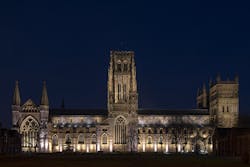Durham Cathedral, a UNESCO World Heritage site, goes LED. Again. (UPDATED)
What do you do when the LED lights that illuminate the façade of your UNESCO World Heritage cathedral keep failing? On top of that, how do you deal with the frustration of having to use gels every time you want to change the colors?
In the case of the approximately 900-year-old Durham Cathedral in the north of England, you change suppliers. And this time, you go for an RGB system rather than the previous white.
“While the current system was installed only ten years ago, it was in much need of a refresh as the lights kept failing,” said Maya Polenz, chief property officer for the historic church that houses relics and remains of St. Cuthbert, The Venerable Bede, and St. Oswald (for readers less familiar with Anglo-Saxon history: these were important folks).
Yes, LED lights can fail. Although Polenz wasn’t saying who provided the first round, in 2014, LEDs Magazine reported that Stainton Lighting Design Services and Urbis Schréder designed the scheme, and AK Lighting and Signs installed it, with customized Urbis Schréder and Philips fixtures playing key roles. The parties in the new installation are not saying who was responsible for the earlier misfirings, and/or if the first set of lights simply ran their natural course.
But this time around, Durham turned to a neighbor — Thorn Lighting, the British subsidiary of Dornbirn, Austria’s Zumtobel Group, based a few miles away in Spennymoor, England. Both Thorn and the Cathedral are part of Durham County.
Thorn was already providing streetlights to Durham County Council, which was financing the Cathedral lighting overhaul, so it seemed like a natural fit to tap them again.
It helped that Thorn was standing by with its Contrast line of integrated RGBW floodlights and wireless DMX controls that would allow the Cathedral to change colors as befitting various occasions and ceremonies. Contrast mixes multichip LEDs in a single lens and is available with multiple beam angles and shapes; at Durham, Thorn deployed a combination of narrow, medium, and elliptical distributions.
The parties did not reveal the price of the project, which Thorn completed in March, using four floods and 16 narrow beam luminaires to light the central tower, with the aim of minimizing stray light.
Thorn further described the project by noting, “All wide beam floods were replaced with either narrow or medium beam optics to provide greater control and intensity of the Cathedral’s architectural features. The optical control is especially important on projects where RGBW is used to minimize overlap of beams where the purpose is to accentuate features of the building. For the Cathedral, medium beams were used on the walls and 10×40 elliptical beams to project light up, supporting the buttresses and increasing the definition and contrast of these features.”
So far, the buyers like what they see.
“The new lighting will allow people to appreciate the Cathedral at night with a new perspective, while it also enhances the current structure and ensures the lights will be kept on for years to come,” said Durham County Councillor John Shuttleworth, a Cabinet member for rural communities and highways.
“This new system will once again showcase the Cathedral in all its glory, as an icon of worship, history, and heritage on Durham’s landscape,” noted the Cathedral’s Polenz. ‘We are grateful to Durham County Council for the investment, which will enable a reduction in our carbon footprint whilst enabling the building to be fully illuminated again.”
Have a gander at the photos. If you’ve never been but you’re feeling a sense of familiarity, here’s a possible reason why: the Cathedral (about 40 years of original construction started in 1093) was used as a setting in the first two Harry Potter films.
More monument and historic site projects
UNESCO site Wartburg Castle gets LED lighting for 300 exhibits and common areas
St. Peter’s Basilica relights with LEDs
LEC supplies LED lighting for UNESCO-recognized Moroccan capital
MARK HALPER is a contributing editor for LEDs Magazine, and an energy, technology, and business journalist ([email protected]).
*Updated June 14, 2022 12:52 PM for clarification on the characterization of first-generation LED lighting and services provided for this project.
For up-to-the-minute LED and SSL updates, follow us on Twitter. You’ll find curated content and commentary, as well as information on industry events, webcasts, and surveys on our LinkedIn page and our Facebook page.

Mark Halper | Contributing Editor, LEDs Magazine, and Business/Energy/Technology Journalist
Mark Halper is a freelance business, technology, and science journalist who covers everything from media moguls to subatomic particles. Halper has written from locations around the world for TIME Magazine, Fortune, Forbes, the New York Times, the Financial Times, the Guardian, CBS, Wired, and many others. A US citizen living in Britain, he cut his journalism teeth cutting and pasting copy for an English-language daily newspaper in Mexico City. Halper has a BA in history from Cornell University.






